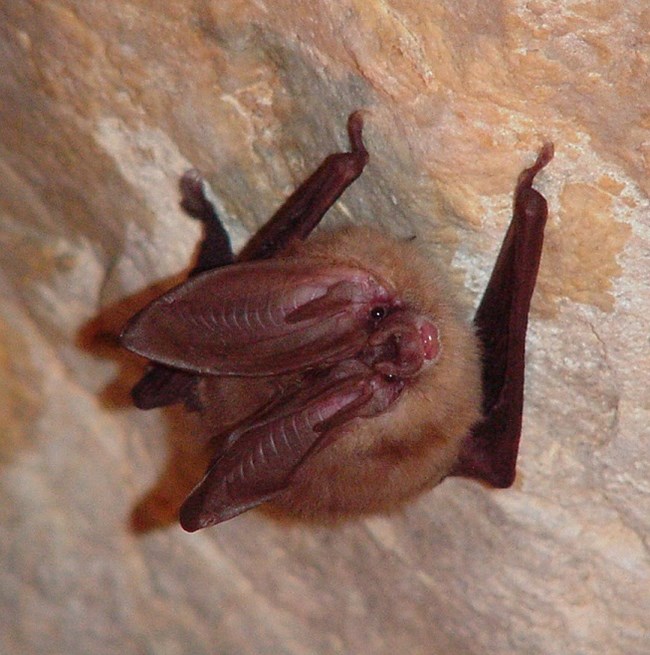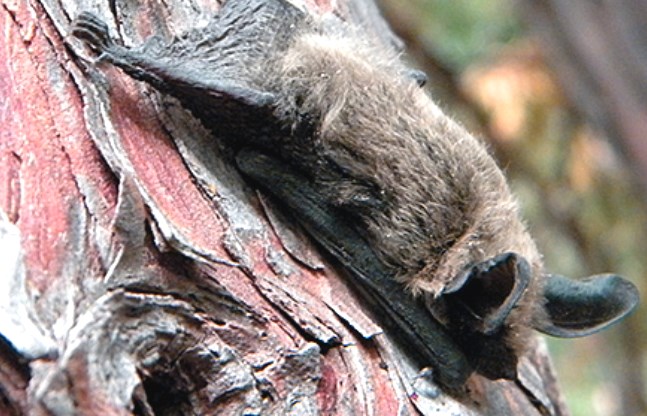Last updated: March 22, 2019
Article
Bat Acoustic Monitoring at Wind Cave National Park

NPS/Timpanogos Cave National Monument
Overview
Wind Cave National Park is a 33,924-acre park in the southern Black Hills in western South Dakota that conserves the namesake cave and the landscapes and associated wildlife above. Wind Cave and other small caves on the park do not appear to be hibernacula (winter homes) or roosting sites for large numbers of bats, probably due to unsuitable climate in the caves. Although very small numbers of overwintering bats (groups of less than 14) have been found in the caves, the limestone cliffs and forests on the park likely provide good bat roosting habitat. Several perennial streams, sewage ponds, and seasonal ponds in wet years provide drinking water for bats.
The Northern Great Plains Inventory & Monitoring Network monitors bats to detect long-term trends and to get early warning of undesirable changes in bat populations at the park. A fungal disease called white-nose syndrome is spreading quickly, threatening bat populations in North America. First documented in a New York cave in 2006, this disease is associated with more than seven million bat deaths. It spreads primarily from bat to bat and humans might be spreading the disease by carrying nearly invisible fungal sporses on their shoes and clothing from one cave to another. Bat monitoring helps us understand changes occurring with the spread of this devastating disease.
Acoustic Monitoring
Four recording stations and one mobile recording route were established in 2014 at Wind Cave National Park for long-term bat monitoring. Acoustic recorders detect the unique ultrasonic calls bats use for echolocation. There were 48,666 bat call recordings from stations across all survey nights from 2014–2017. The data were analyzed through specialized software programs that make preliminary identifications of the bat species based on individual call characteristics, such as frequency and shape. Some bat species make calls that are similar to other species, which is why researchers with special expertise review the calls and make the final species determinations.

NPS
Bats at the Park (2014–2017)
| Common Name | Scientific Name | 2014–2017 Status |
|---|---|---|
| Townsend's big-eared bat | Corynorhinus townsendii | Present |
| Big brown bat | Eptesicus fuscus | Present |
| Eastern red bat | Lasiurus borealis | Present |
| Hoary bat | Lasiurus cinereus | Present |
| Silver-haired bat | Lasionycteris noctivagans | Present |
| Western small-footed myotis | Myotis ciliolabrum | Present |
| Little brown bat | Myotis lucifugus | Present |
| Northern long-eared bat | Myotis septentrionalis | Present |
| Fringed myotis | Myotis thysanodes | Present |
| Long-legged myotis | Myotis volans | Present |
| Tri-colored bat | Perimyotis subflavus | Present |
- Silver-haired bats were recorded most often followed by big brown, hoary, and little brown bats. Hear what a big brown bat sounds like!
- Tri-colored bats were a new detection for Wind Cave National Park, their presence was confirmed through acoustic monitoring and cave surveys. Long-legged myotis, historically common in the Black Hills, were a small component of the Wind Cave National Park bat community.
- Threatened northern long-eared bats were rarely identified by the software, but recent mist-netting confirmed their presence. This species has been severely impacted by white-nose syndrome and populations nationwide have decreased rapidly in recent years.
- The highest rate of bat detections was at the station near the sewage pond, which is the largest body of permanent surface water in the park. The sewage pond may play a critical role in bat reproduction as lactating females make regular use of surface water. The station in the prairie habitat had the least bat activity.
- The bat community in the park appears to be abundant, diverse, and stable. Conserving forests and woody debris is important for protecting the bat populations at Wind Cave National Park.

NPS
White-nose Syndrome
White-nose syndrome has not yet been detected at the park, but the fungus (Pseudogymnoascus destructans) that causes it was detected in 2017 on bats at Badlands National Park just east of Wind Cave National Park. See a map of white-nose syndrome in national parks and learn more about how you can help prevent the spread of this fungus. Wind Cave National Park has an active management program to prevent spread of this disease; clothing, shoes, and gear that have been in any eastern caves are not allowed in Wind Cave. Continued monitoring, and park staff and visitor observations, will help us protect the rich bat communities that live and forage in the park.
For More Information
Dan Licht, Midwest Region Wildlife Biologist
Protocol Contact: Northern Great Plains Network
Summary by Tani Hubbard, updated in 2019
